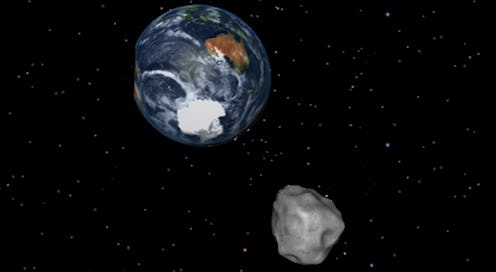News
Really Big Asteroid Gets Really Close To Earth

All it takes to remind us that Earth is a tiny blip in the solar system is an asteroid as big as three football fields, which swept past Earth at 27,000 m.p.h. Monday. The asteroid, catchily named 2000 EM26, flew about two million miles from Earth on Monday evening at around 9 p.m. EST. That might not seem close, but it's only a stone's throw away in the eyes of astrologists. Scientists are also intrigued that the "close call" came on the heels of a destructive asteroid explosion over Russia almost exactly a year ago.
Dr. Ian O'Neill, senior news producer for the Discovery Channel, wrote in a blog post: "This is our warning from the cosmos." Experts like O'Neill had predicted that the 2000 EM26 asteroid would pass about 17,000 miles away from Earth, making it the nearest miss in recent years. Last night, the best view of the asteroid could be seen from Indonesia.
And though the asteroid's distance was further away than researchers thought, scientists were still able radioactive waves to study its composition. O'Neill wrote that the asteroid was slingshotted away, and will likely make a return trip in about three decades.
Slooh, a robotic telescope service, hoped to broadcast the event to people at home. However, its telescope equipment in the Canary Islands froze over and wasn't able to show any photos of the asteroid. (But it's good to know we'll always have a live feed if doomsday strikes, right?)
"We continue to discover these potentially hazardous asteroids — sometimes only days before they make their close approaches to Earth," Paul Cox, Slooh's technical research director, told Reuters in a statement. "Slooh's asteroid research campaign is gathering momentum with Slooh members using the Slooh robotic telescopes to monitor this huge population of potentially hazardous space rocks. We need to find them before they find us."
On Feb. 15, 2013, an asteroid lit up the sky over Chelyabinsk, Russia. The meteor hit Earth with a sonic boom so loud that it shattered glass and damaged buildings, injuring about 1,500 people. It struck almost exactly a year ago, nearly to the day.
Image: NASA